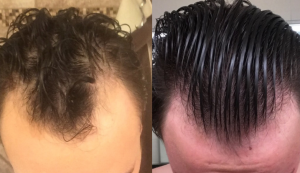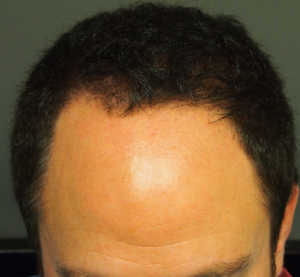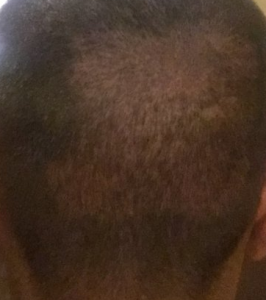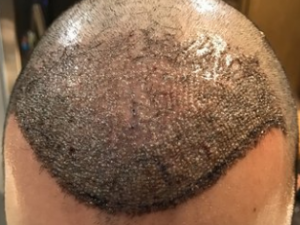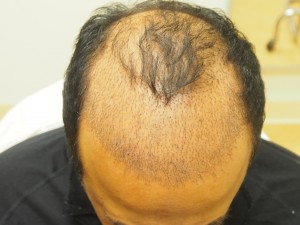Hair loss is a progressive process, so when you have early crown loss in your early 20s, you can expect this to slowly get worse at a pace consistent with your genetic clock for hair loss. Everyone is different and many such men will develop a receding hairline as well.
https://www.ncbi.nlm.nih.gov/pmc/articles/PMC5346286/
I personally feel that it is my job to inform patients of risks associated with anything I do, so consistent with this believe, I have included this article for the readers consideration without further comment. There is a balance of taking such risks against the value of stopping of slowing the hair loss. These are decisions that only the patient can make. These published “studies” were unfortunately done without adhering to ‘evidence based medicine guidelines’…like having an age matched control group. There are many causes of ED that aren’t age related, too. Marijuana use, for one, appears to have a negative effect and as this becomes more widely legalized we can anticipate higher incidence.
Authors Conclusions: “In conclusion, among men with 5?-RI exposure, duration of 5?-RI exposure was a more accurate predictor of PED than all other assessed risk factors except prostate disease and prostate surgery. Among young men with 5?-RI exposure, duration of 5?-RI exposure was a more accurate predictor of PED than all other assessed risk factors. For each 108 young men exposed for >205 days to the finasteride dose typically used for androgenic alopecia (?1.25 mg/day), one additional young man experienced PED when compared to those men with shorter exposure. The median duration of PED in young men was 1,534 days. We expect that our finding of an association between debilitating sexual dysfunction and exposure to finasteride or dutasteride will be of particular interest to prescribers and patients considering medical management of androgenic alopecia or symptomatic treatment of prostatic hyperplasia.”
The good news is that most men who take finasteride, don’t have the sexual side effect, or any side effects, nevertheless, everyone who does take it must be aware of the risks as outlined in this article.
Some doctors say that smoking reduces the blood supply to the scalp and causes hair loss in those prone to it through genetic balding. I don’t believe that there is any evidence that this is true.
They say photos are worth 1000 words. The type of change here may be seen in men under 30, the younger they are, the greater the chance of having this happen. Keep in mind, when genetic hair loss is very, very active leading to an advanced hair loss pattern at an early age, the drug may not produce such a miraculous impact as shown in these photos.
Finasteride (Propecia) shedding, when it happens, rarely lasts more than 2-3 months. To my knowledge, it is neither good nor bad. When it lasts more than 3 months, it usually is genetic balding not shedding from the finaasteride.
I often prescribe finasteride to young men who want it. This type of change (shown here) is not the usual impact I see but it does happen maybe in 10% of the young men I treat. It happened in my son who took the drug and reversed it in a year. It stayed reversed now 14 years later.
I have been contracted by the author of the site: https://hairlosstests.com/. The author is a geneticist and believes that the genes present that are detected by the saliva tests performed through the 23&me website, may predict your hair loss pattern. Of course, we have known that there is a clear genetic relationship in family lines, so this might be worth exploring for those of you with curious minds. I have use the 23&me website for years to look at my ancestry along with many members of my family.
“I thought I would share my hair story with you. I am sure you hear many stories like this one. After the hair transplant grew in, I felt different, more confident, more self-assured. People told this to me but, to my surprise, no one noticed my hair transplant. You know, you can tell if someone looks at your hairline – it didn’t happen. I felt that women were more receptive to me as they smiled at me more often. Then one day, I spoke with a woman on the train, during an afternoon commute going home. By coincidence, we both got off at the same stop. We passed by a Starbucks and sat for a cup of coffee. As I guess you can tell, it only gets better. Now we are a couple. I used to think that women discriminated against me because of my hairline, but Dr. Rassman said: ‘it was all in my head not on my head’. There is no doubt, nevertheless, that this hair transplant changed me both inside and out. A great decision!
I patient of mine, a very straight laced accountant, had two hair transplant procedures performed by me some years ago. He had been pushed to get into ‘working out’ by his kids, so he went to a gym and got a trainer. During their ‘get to know each other session’ she asked him if his father had hair as good as he did. Maybe her boyfriend was having a bad hair day, who knows. He told her that his father was balding and ‘”I guess I am lucky’.
When he want home and told his wife about this conversation, he told his wife that he felt guilty for having lied about his hair, His wife quickly responded: “Well if a woman stuffed her bra, do you think she would tell anyone?”
They both laughed and I thought it was worth repeating the story here.
In a Denmark Study, people who “redeemed five or more antibiotic prescriptions over the course of a 15 year period were much more likely to develop type 2 diabetes compared with those who took antibiotics’ only noe or two times. Other diseases were also appearing that may be the result of altering the bacteria in our intestine finding associations with “obesity, inflammatory and autoimmune disorders and even depression”.
Since the 1940s with the discovery of antibiotics, the focus was to kill all of the bad ‘germs’ in our body, but maybe we just killed off the good ‘germs’ in the process and without these good ‘germs’, we found ourselves with many other diseases. Children may have been over-treated causing more asthma and a tendency to obesity.
I have read much about the value of our ‘gut’ to help our immune system function properly. The learning curve is very steep at this time and it seems that in almost every medical journal now appearing, we are learning that our intestine is really a functioning part of our immune system, something I never learned in medical school.
I found myself being asked many times by patients to give them an antibiotic for a flu. I know it did not work against a virus, but the patients would demand antibiotics and although I may have been one of the few doctors who resisted such calls for antibiotics, I could not always stand my ground. So what I am telling you here is not to demand Antibiotics when you are not feeling well, as you might be harming yourself if you took them unnecessarily.
This was discussed in New Scientist, April 8-13, Pages 39-41.
This patient had a localized harvest of his donor area with FUE. The area extended outside the permanent zone of hair which means that the patient has had hair moved from areas which are not permanent and that the harvest with FUE may have been too great. We see this complication of large FUE sessions, that some of these patients develop a ‘balding’ of the hair in the back of their head. I have spoken against over-harvesting for many years since I originally defined FUE
This patient had frontal grafts and is one day post-op. What amazes me is the awful appearance of the transplant. I can’t imagine being the patient and having to hide under a hat. This type of look is totally unacceptable to me. Also, if you look closely at the top photo, you will see that the grafts were put in as concentric rings, patterns that can be easily seen. This will show when the grafts become hair and assuming all of the grafts grown, the hair will be lined up with a distinct pattern, obvious to an observer. The two pictures shown here are shown for comparison. Our patient does not have the crusts (lower photo). The crusts on the upper photos will almost certainly last for 2-4 weeks.
I have seen men reach a full Class 7 balding pattern by the age of 21. Most men with advanced balding patterns get them by the time they are 26 years old.
Finasteride does change the entire testosterone metabolic pathway. We know, for example, that people taking finasteride often see a rise in their testosterone levels; however, the DHT hormone which is a metabolic product of testosterone metabolism, is a hormone that is 40 times as powerful an androgen as testosterone. Finasteride blocks the action of DHT at about 70% effectiveness. This is, as you say, ‘messing with hormones’ and for every benefit in life, there is often a down side. What each and everyone of us must know if we consider taking finasteride, is that this drug does ‘mess with your hormones’ maybe insignificantly, maybe not.
For those of us in the field of hair restoration, we have waited for the day when stems cells could be used to activate hair. In my previous post, I linked an article on Progenerator cells and their role in hair regeneration. With the opening of this Stem Cell Bank in the UK, the access to stem cell lines may accelerate the development of solutions for hair loss. Read here:
https://www.the-scientist.com/?articles.view/articleNo/49155/title/First-Clinic-Ready-Stem-Cell-Repository/&utm_campaign=NEWSLETTER_TS_The-Scientist-Daily_2016&utm_source=hs_email&utm_medium=email&utm_content=50176304&_hsenc=p2ANqtz-8s5kMWttlyETUROd55IBcDNPnyw5I3qwuBFwEb3FIExWjK-_fnAKMRXolTwLJSwD82pJJlCOcxljKw3-wlRj_FGybjzg&_hsmi=50176304
I have always believed that as a cosmetic surgeon my job is to meet the needs of my patients. Sometimes, however, the person’s needs do not conform to my willingness to deliver what they want. Here are three examples of different needs. The person on the left is not dissimilar to some of my patients who do not want to see the scalp so the pigments can be placed to cover the entire scalp, essentially painting the scalp. It might work if there was hair on top of it, but with a shaved head it is an example distinctly to the extreme. The person in the middle is more of a classic tattoo statement and has nothing to do with Scalp MicroPigmentation which we do every day in our office. I hope he loves it but it does nothing for me. The last person on the right is one of our typical Scalp MicroPigmentation patients. Each man addresses the tattoo process differently and all three had balding. Which one can you identify with?

